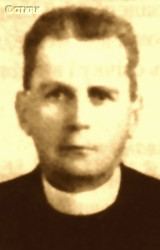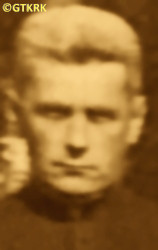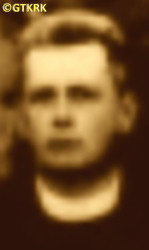Roman Catholic
St Sigismund parish
05-507 Słomczyn
85 Wiślana Str.
Konstancin deanery
Warsaw archdiocese, Poland
full list:
displayClick to display full list

searchClick to search full list by categories
wyświetlKliknij by wyświetlić pełną listę po polsku

szukajKliknij by przeszukać listę wg kategorii po polsku

Martyrology of the clergy — Poland
XX century (1914 – 1989)
personal data
surname
KOŁTUNIUK
forename(s)
Myron John (pl. Miron Jan)
forename(s)
versions/aliases
Myron Ivan (pl. Miron Iwan)

function
eparchial priest
creed
Ukrainian Greek Catholic GCmore on
en.wikipedia.org
[access: 2013.05.19]
diocese / province
Przemyśl GC eparchymore on
pl.wikipedia.org
[access: 2013.05.19]
nationality
Ukrainian
date and place
of death
28.07.1943

Żukówtoday: Cieszanów gm., Lubaczów pov., Subcarpathia voiv., Poland
more on
en.wikipedia.org
[access: 2021.08.20]
details of death
At the beginning of the World War I arrested in 08.1914 by the Austrian and accused of shooting an Austrian army soldier (of Czech nationality who apparently shot himself to avoid further service).
Held in Cieszanów prison.
Released but soon on 13.09.1914 arrested again by the Austrian in Krzeczowice n. Przeworsk during an escape west from advancing Russian troops and interned in IL Thalerhof internment camp.
Released after a month, on 07.10.1914, thanks to intervention of high placed Ukrainian authorities.
Next drafted as a chaplain of 30th Regiment of Austro–Hungarian army.
During Polish–Ukrainian war of 1918‐1919 chaplain of Ukrainian Galician Army UHA.
After German and Russian invasion of Poland in 09.1939 and start of the World War II, after start of Russian occupation, collaborated — according to Polish sources — with German occupiers and helped to point out Poles selected for forced labour in Germany.
Executed after death sentence was passed on him by the clandestine Special Military Court of Polish resistance Home Army AK (part of Polish Clandestine State).
According to Ukrainian sources perished during the partisan attack on his rectory and robbery.
cause of death
murder
perpetrators
Poles
sites and events
Slave labour in GermanyClick to display the description, GeneralgouvernementClick to display the description, Ribbentrop‐MolotovClick to display the description, Pius XI's encyclicalsClick to display the description, Polish‐Ukrainian war of 1918‐1919Click to display the description, IL ThalerhofClick to display the description
date and place
of birth
19.01.1885

Komarnotoday: Komarno urban hrom., Lviv rai., Lviv obl., Ukraine
more on
en.wikipedia.org
[access: 2021.12.19]
parents
KOŁTUNIUK Nicholas
🞲 1857, ? — 🕆 26.03.1911, Żukówtoday: Cieszanów gm., Lubaczów pov., Subcarpathia voiv., Poland
more on
en.wikipedia.org
[access: 2021.08.20]

JAJUS Olga
🞲 ?, ? — 🕆 ?, ?
presbyter (holy orders)
ordination
22.12.1912

Przemyśltoday: Przemyśl city pov., Subcarpathia voiv., Poland
more on
en.wikipedia.org
[access: 2021.04.01]
St Therese GC cathedral churchmore on
en.wikipedia.org
[access: 2025.03.14]
positions held
1936 – 1943
dean — Cieszanówtoday: Cieszanów gm., Lubaczów pov., Subcarpathia voiv., Poland
more on
en.wikipedia.org
[access: 2020.11.20] GC deanery
1926 – 1943
parish priest — Żukówtoday: Cieszanów gm., Lubaczów pov., Subcarpathia voiv., Poland
more on
en.wikipedia.org
[access: 2021.08.20] ⋄ Nativity of the Blessed Virgin Mary GC parish ⋄ Cieszanówtoday: Cieszanów gm., Lubaczów pov., Subcarpathia voiv., Poland
more on
en.wikipedia.org
[access: 2020.11.20] GC deanery
1925 – 1926
vicar — Żukówtoday: Cieszanów gm., Lubaczów pov., Subcarpathia voiv., Poland
more on
en.wikipedia.org
[access: 2021.08.20] ⋄ Nativity of the Blessed Virgin Mary GC parish ⋄ Cieszanówtoday: Cieszanów gm., Lubaczów pov., Subcarpathia voiv., Poland
more on
en.wikipedia.org
[access: 2020.11.20] GC deanery
1925
vicar — Vovche Verkhnetoday: Vovche, Turka urban hrom., Sambir rai., Lviv obl., Ukraine
more on
uk.wikipedia.org
[access: 2023.03.02] ⋄ Nativity of the Blessed Virgin Mary GC parish ⋄ Zhukotyntoday: Turka urban hrom., Sambir rai., Lviv obl., Ukraine
more on
uk.wikipedia.org
[access: 2023.03.02] GC deanery
1925
administrator — Nowosielce‐Gniewosztoday: Nowosielce, Zarszyn gm., Sanok pov., Subcarpathia voiv., Poland
more on
en.wikipedia.org
[access: 2022.01.22] ⋄ Intercession of the Blessed Virgin Mary GC parish ⋄ Bukowskotoday: Bukowsko gm., Sanok pov., Subcarpathia voiv., Poland
more on
en.wikipedia.org
[access: 2021.10.09] GC deanery
1925
administrator — Jurowcetoday: Sanok gm., Sanok pov., Subcarpathia voiv., Poland
more on
en.wikipedia.org
[access: 2022.01.16] ⋄ St George the Martyr GC parish ⋄ Sanoktoday: Sanok urban gm., Sanok pov., Subcarpathia voiv., Poland
more on
en.wikipedia.org
[access: 2021.10.09] GC deanery
1919 – 1925
administrator — Olszanytoday: Krasiczyn gm., Przemyśl pov., Subcarpathia voiv., Poland
more on
en.wikipedia.org
[access: 2022.01.16] ⋄ St Michael the Archangel GC parish ⋄ Niżankowice / Przemyśldeanery names/seats GC deanery
c. 1919
GC military chaplain — Ukrainian Galician Army UHA
1916 – 11.11.1918
chaplain — Germ. Militärgeneralgouvernement Lublin (Eng. Lublin General Governorate), Austro–Hungarian Imperial Army — district chaplain for Olkusz, Miechów, Dąbrowa, Włoszczowa and the Jasna Góra monastery in Częstochowa districts; in 10.1918 ministered, among others, in Starczynów, c. 8 km from Olkusz, in the local endemic hospital
1913 – 1914
vicar — Lubliniecalso: Stary Lubliniec
today: Cieszanów gm., Lubaczów pov., Subcarpathia voiv., Poland
more on
en.wikipedia.org
[access: 2022.01.16] ⋄ Transfiguration of the Lord GC parish ⋄ Lubaczówtoday: Lubaczów urban gm., Lubaczów pov., Subcarpathia voiv., Poland
more on
en.wikipedia.org
[access: 2020.11.20] GC deanery
1912 – 1913
vicar — Sebechivtoday: Belz urban hrom., Sheptytskyi rai., Lviv obl., Ukraine
more on
uk.wikipedia.org
[access: 2023.03.02] ⋄ Ascension of the Lord GC parish ⋄ Belztoday: Belz urban hrom., Sheptytskyi rai., Lviv obl., Ukraine
more on
en.wikipedia.org
[access: 2020.11.15] GC deanery
1909 – 1910
student — Przemyśltoday: Przemyśl city pov., Subcarpathia voiv., Poland
more on
en.wikipedia.org
[access: 2021.04.01] ⋄ philosophy and theology, Greek Catholic Theological Seminary
1906 – 1909
student — Lvivtoday: Lviv urban hrom., Lviv rai., Lviv obl., Ukraine
more on
en.wikipedia.org
[access: 2022.01.16] ⋄ philosophy and theology, Greek Catholic Theological Seminary
married — two children
sites and events
descriptions
Slave labour in Germany: During World War II Germans forced c. 15 million people to do a slave forced labour in Germany and in the territories occupied by Germany. In General Governorate the obligation to work included Poles from 14 to 60 years old. On the Polish territories occupied and incorporated into Germany proper obligation was forced upon children as young as 12 years old — for instance in Warthegau (Eng. Greater Poland). (more on: en.wikipedia.orgClick to attempt to display webpage
[access: 2017.11.07])
Generalgouvernement: After the Polish defeat in the 09.1939 campaign, which was the result of the Ribbentrop‐Molotov Pact and constituted the first stage of World War II, and the beginning of German occupation in part of Poland (in the other, eastern part of Poland, the Russian occupation began), the Germans divided the occupied Polish territory into five main regions. In two of them new German provinces were created, two other were incorporated into other provinces. However, the fifth part was treated separately, and in a political sense it was supposed to recreate the German idea from 1915 (during World War I, after the defeat of the Russians in the Battle of Gorlice in 05.1915) of creating a Polish enclave within Germany. Illegal in the sense of international law, i.e. Hague Convention, and public law, managed by the Germans according to separate laws — especially established for the Polish Germ. Untermenschen (Eng. subhumans) — till the Russian offensive in 1945 it constituted part of the Germ. Großdeutschland (Eng. Greater Germany). Till 31.07.1940 formally called Germ. Generalgouvernement für die besetzten polnischen Gebiete (Eng. General Government for the occupied Polish lands) — later simply Germ. Generalgouvernement (Eng. General Governorate), as in the years 1915‐1918. From 07.1941, i.e. after the German attack on 22.06.1941 against the erstwhile ally, the Russians, it also included the Galicia district, i.e. the Polish pre‐war south‐eastern voivodeships. A special criminal law was enacted and applied to Poles and Jews, allowing for the arbitrary administration of the death penalty regardless of the age of the „perpetrator”, and sanctioning the use of collective responsibility. After the end of the military conflict of the World War UU, the government of the Germ. Generalgouvernement was recognized as a criminal organization, and its leader, governor Hans Frank, guilty of war crimes and crimes against humanity and executed. (more on: en.wikipedia.orgClick to attempt to display webpage
[access: 2024.12.13])
Ribbentrop‐Molotov: Genocidal Russian‐German alliance pact between Russian leader Joseph Stalin and German leader Adolf Hitler signed on 23.08.1939 in Moscow by respective foreign ministers, Mr. Vyacheslav Molotov for Russia and Joachim von Ribbentrop for Germany. The pact sanctioned and was the direct cause of joint Russian and German invasion of Poland and the outbreak of the World War II in 09.1939. In a political sense, the pact was an attempt to restore the status quo ante before 1914, with one exception, namely the „commercial” exchange of the so‐called „Kingdom of Poland”, which in 1914 was part of the Russian Empire, fore Eastern Galicia (today's western Ukraine), in 1914 belonging to the Austro‐Hungarian Empire. Galicia, including Lviv, was to be taken over by the Russians, the „Kingdom of Poland” — under the name of the General Governorate — Germany. The resultant „war was one of the greatest calamities and dramas of humanity in history, for two atheistic and anti‐Christian ideologies — national and international socialism — rejected God and His fifth Decalogue commandment: Thou shall not kill!” (Abp Stanislav Gądecki, 01.09.2019). The decisions taken — backed up by the betrayal of the formal allies of Poland, France and Germany, which on 12.09.1939, at a joint conference in Abbeville, decided not to provide aid to attacked Poland and not to take military action against Germany (a clear breach of treaty obligations with Poland) — were on 28.09.1939 slightly altered and made more precise when a treaty on „German‐Russian boundaries and friendship” was agreed by the same murderous signatories. One of its findings was establishment of spheres of influence in Central and Eastern Europe and in consequence IV partition of Poland. In one of its secret annexes agreed, that: „the Signatories will not tolerate on its respective territories any Polish propaganda that affects the territory of the other Side. On their respective territories they will suppress all such propaganda and inform each other of the measures taken to accomplish it”. The agreements resulted in a series of meeting between two genocidal organization representing both sides — German Gestapo and Russian NKVD when coordination of efforts to exterminate Polish intelligentsia and Polish leading classes (in Germany called «Intelligenzaktion», in Russia took the form of Katyń massacres) where discussed. Resulted in deaths of hundreds of thousands of Polish intelligentsia, including thousands of priests presented here, and tens of millions of ordinary people,. The results of this Russian‐German pact lasted till 1989 and are still in evidence even today. (more on: en.wikipedia.orgClick to attempt to display webpage
[access: 2015.09.30])
Pius XI's encyclicals: Facing the creation of two totalitarian systems in Europe, which seemed to compete with each other, though there were more similarities than contradictions between them, Pope Pius XI issued in 03.1937 (within 5 days) two encyclicals. In the „Mit brennender Sorge” (Eng. „With Burning Concern”) published on 14.03.1938, condemned the national socialism prevailing in Germany. The Pope wrote: „Whoever, following the old Germanic‐pre‐Christian beliefs, puts various impersonal fate in the place of a personal God, denies the wisdom of God and Providence […], whoever exalts earthly values: race or nation, or state, or state system, representatives of state power or other fundamental values of human society, […] and makes them the highest standard of all values, including religious ones, and idolizes them, this one […] is far from true faith in God and from a worldview corresponding to such faith”. On 19.03.1937, published „Divini Redemptoris” (Eng. „Divine Redeemer”), in which criticized Russian communism, dialectical materialism and the class struggle theory. The Pope wrote: „Communism deprives man of freedom, and therefore the spiritual basis of all life norms. It deprives the human person of all his dignity and any moral support with which he could resist the onslaught of blind passions […] This is the new gospel that Bolshevik and godless communism preaches as a message of salvation and redemption of humanity”… Pius XI demanded that the established human law be subjected to the natural law of God , recommended the implementation of the ideal of a Christian state and society, and called on Catholics to resist. Two years later, National Socialist Germany and Communist Russia came together and started World War II. (more on: www.vatican.vaClick to attempt to display webpage
[access: 2023.05.28], www.vatican.vaClick to attempt to display webpage
[access: 2023.05.28])
Polish‐Ukrainian war of 1918‐1919: One of the wars for borders of the newly reborn Poland. At the end of 1918 on the former Austro‐Hungarian empire’s territory, based on the Ukrainian military units of the former Austro‐Hungarian army, Ukrainians waged war against Poland. In particular attempted to create foundation of an independent state and attacked Lviv. Thanks to heroic stance of Lviv inhabitants, in particular young generation of Poles — called since then Lviv eaglets — the city was recaptured by Poles and for a number of months successfully defended against furious Ukrainian attacks. In 1919 Poland — its newly created army — pushed Ukrainian forces far to the east and south, regaining control over its territory. (more on: en.wikipedia.orgClick to attempt to display webpage
[access: 2017.05.20])
IL Thalerhof: Germ. „Internierungslager” (Eng. „Internment camp”) for Rusyns and Lemkovs for Galicia and Bukovina, accused of „ Moscow sympathies”, set up by Austro‐Hungarian Empire in war with Russian Empire, built n. Graz in Austria (on the lands Graz airport today is located on), and operational during World War I, from 04.09.1914 to c. 10.05.1917. Altogether 14,000‐20,000, including more than 350 priest of Greek Catholic Church — prisoner were held captive. Prisoners were subjected to very harsh, inhumane conditions. During first year there were no barracks and internees had to sleep on the ground. Typhus and cholera outbreaks were noted. Austrians recorded 1.757 death cases. Other sources claim 3,000. Executions were also carried out there. (more on: en.wikipedia.orgClick to attempt to display webpage
[access: 2015.09.30])
sources
personal:
www.vox-populi.com.uaClick to attempt to display webpage
[access: 2015.03.01], mbp.cieszanow.archiwa.orgClick to attempt to display webpage
[access: 2015.03.01], talergof.org.uaClick to attempt to display webpage
[access: 2020.04.04]
bibliographical:
„Clergy of Przemyśl Eparchy and Apostolic Exarchate of Lemkivshchyna”, Bogdan Prach, Ukrainian Catholic University Publishing House, Lviv 2015
original images:
www.vox-populi.com.uaClick to attempt to display webpage
[access: 2015.03.01], mbp.cieszanow.archiwa.orgClick to attempt to display webpage
[access: 2015.03.01]
LETTER to CUSTODIAN/ADMINISTRATOR
If you have an Email client on your communicator/computer — such as Mozilla Thunderbird, Windows Mail or Microsoft Outlook, described at WikipediaPatrz:
en.wikipedia.org, among others — try the link below, please:
LETTER to CUSTODIAN/ADMINISTRATORClick and try to call your own Email client
If however you do not run such a client or the above link is not active please send an email to the Custodian/Administrator using your account — in your customary email/correspondence engine — at the following address:

giving the following as the subject:
MARTYROLOGY: KOŁTUNIUK Myron John
To return to the biography press below:
 Click to return to biography
Click to return to biography










